Can Dogs Eat Sushi Rice?
Yes, dogs can eat sushi rice in moderation, as it is easily digestible and provides a good source of carbohydrates for energy. However, it’s important to ensure that the sushi rice is served plain, without harmful ingredients commonly found in sushi, such as raw fish, spicy sauces, or high-fat components like cream cheese. When offering sushi rice, it should be broken into small pieces to prevent choking, and the amount should be adjusted based on the dog’s size.
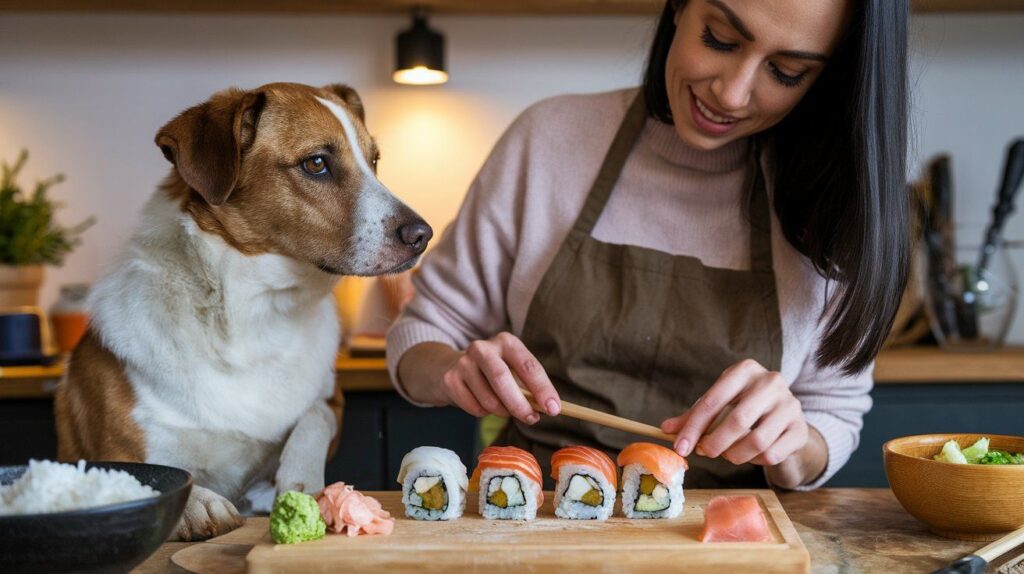
What is Sushi Rice?
Sushi rice, or shari, is a key ingredient in sushi preparation. It is a short-grain rice that becomes sticky when cooked, allowing it to hold together. After cooking, the rice is seasoned with vinegar, sugar, and salt to give it a slightly tangy flavor. The seasoning enhances the texture and flavor, making it ideal for sushi rolls or nigiri. Sushi rice must be cooled to room temperature to maintain its perfect consistency before use.
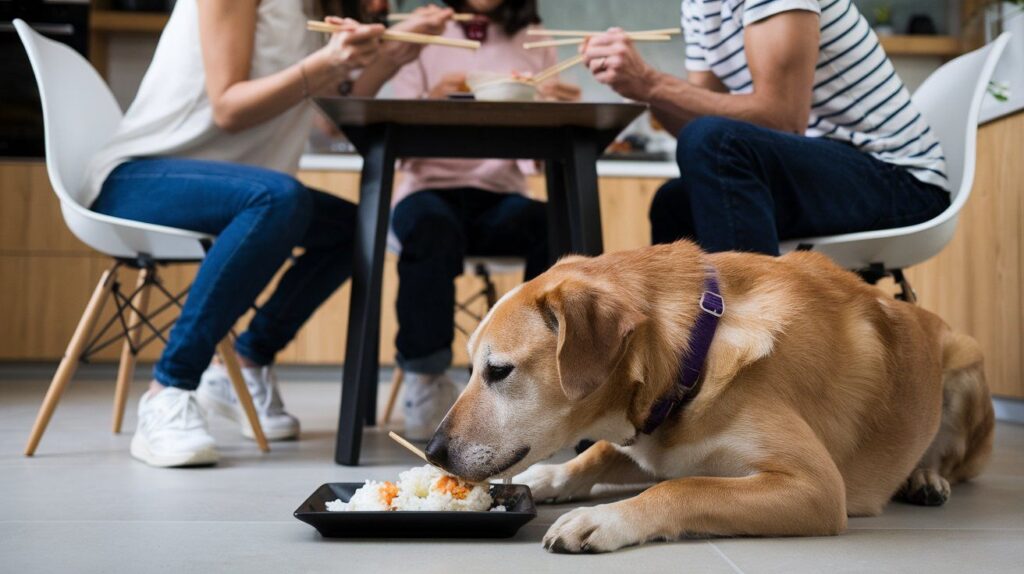
Introduction Sushi Rice to Your Dogs
Sushi rice is known for its unique sweet and tangy taste, which is a crucial part of many sushi dishes. This flavor comes from mixing cooked rice with vinegar, sugar, and salt. Many pet owners who enjoy sushi may wonder if it’s safe to share sushi rice with their dogs, considering their different dietary needs. In this article, we’ll examine whether sushi rice is safe for dogs, examining its nutrition, possible benefits, and risks to help you decide if you can include it in your dog’s meals.
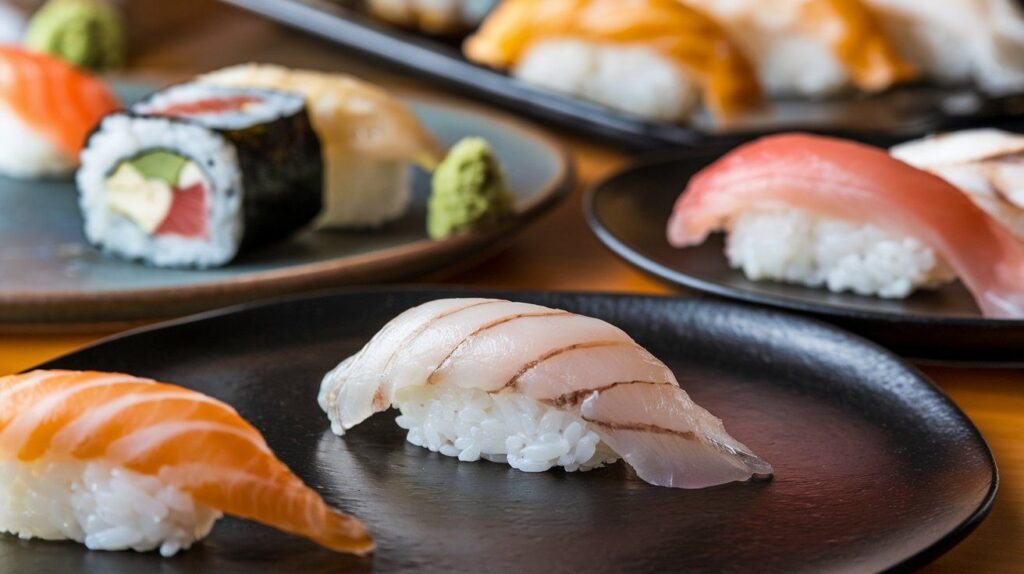
Despite its popularity among humans, pet owners must exercise caution when feeding sushi rice to dogs. Unlike plain rice, which veterinarians often recommend for dogs with digestive issues due to its blandness and ease of digestion, sushi rice contains additives like sugar and salt, which are not advisable for canine consumption. Excessive intake can lead to health issues in dogs, such as sodium ion poisoning or sugar-induced ailments, which can complicate dietary management.
As dog owners, understanding the distinctions between safe and unsafe components in human foods is crucial before sharing them with pets. While plain cooked rice can be a harmless addition to a dog’s diet, sushi rice, with its additional seasonings, strays from this safety due to its enhanced flavor profile and added ingredients.
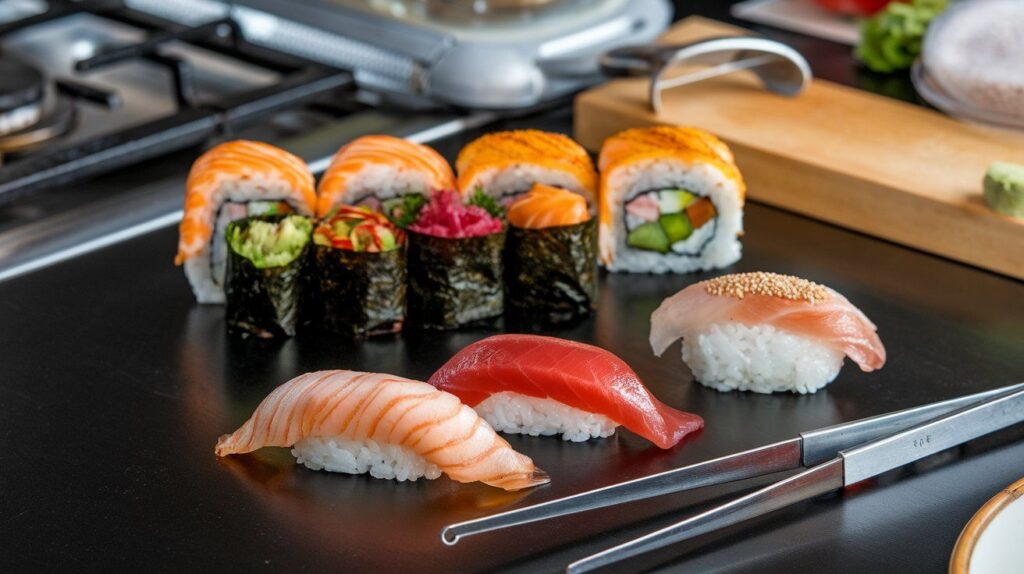
Nutritional Content and Benefits of Sushi Rice
Sushi rice, primarily known for its high carbohydrate content, is a quick energy source. This might seem beneficial, especially for very active dogs who require bursts of energy. However, it’s essential to understand the broader nutritional context when considering sushi rice for your dog’s diet. Sushi rice also contains trace amounts of essential nutrients like thiamine, niacin, iron, and magnesium, which can contribute to overall health.
While the nutritional benefits of sushi rice might tempt some pet owners to include it in their dog’s meals, it’s crucial to consider the form in which it’s served. Plain sushi rice—without the typical seasonings of vinegar, sugar, and salt—can be a safer choice, albeit still not ideal as a regular diet staple. Dogs have different nutritional needs than humans, and their main diet should be high in protein and fats rather than high in carbohydrates, which are the primary components of sushi rice.
For exceptionally active dogs, the carbohydrates in sushi rice might provide a quick energy boost. However, the overall benefit is minimal when considering the potential health risks and the lack of other essential nutrients that dogs require for a balanced diet. Therefore, while sushi rice might be digested easily by some dogs, making it a potentially good option for those with sensitive stomachs, it should only be introduced carefully and occasionally to avoid disrupting their regular nutrient intake.
Here’s a table outlining the nutritional benefits of Sushi Rice based on a 100-gram serving, specifically for dogs. Remember that while sushi rice isn’t a typical dog food, it can be given in moderation. The nutritional content primarily reflects the rice itself, with added ingredients such as vinegar, sugar, and salt minimally affecting the overall profile.
| Nutrient | Amount per 100g Serving | Benefit for Dogs |
|---|---|---|
| Calories | 130 kcal | It is low in fat, making it suitable for dogs with dietary restrictions. |
| Protein | 2.7 g | Supports muscle health and repair. |
| Fat | 0.3 g | Low fat, making it suitable for dogs with dietary restrictions. |
| Carbohydrates | 28.2 g | A good source of digestible carbs for energy. |
| Fiber | 0.4 g | Helps with digestive health and bowel regularity. |
| Sugars | 0.1 g | Minimal sugar content does not contribute to high blood sugar. |
| Calcium | 2 mg | Supports bone health, though not a significant source. |
| Iron | 0.4 mg | Contributes to overall health, aiding in red blood cell production. |
| Magnesium | 12 mg | Important for muscle and nerve function. |
| Sodium | 0 mg | Sushi rice itself has no added sodium, but be cautious if it’s prepared with salt. |
| Potassium | 26 mg | Essential for heart and muscle function. |
| Vitamins | Minimal amounts (B-vitamins) | Minimal amounts (B vitamins) |
Note: Dogs should not consume sushi rice prepared with additional seasonings like excessive vinegar, sugar, or salt, as these can harm their health. It’s always best to consult a veterinarian before introducing new foods into their diet.
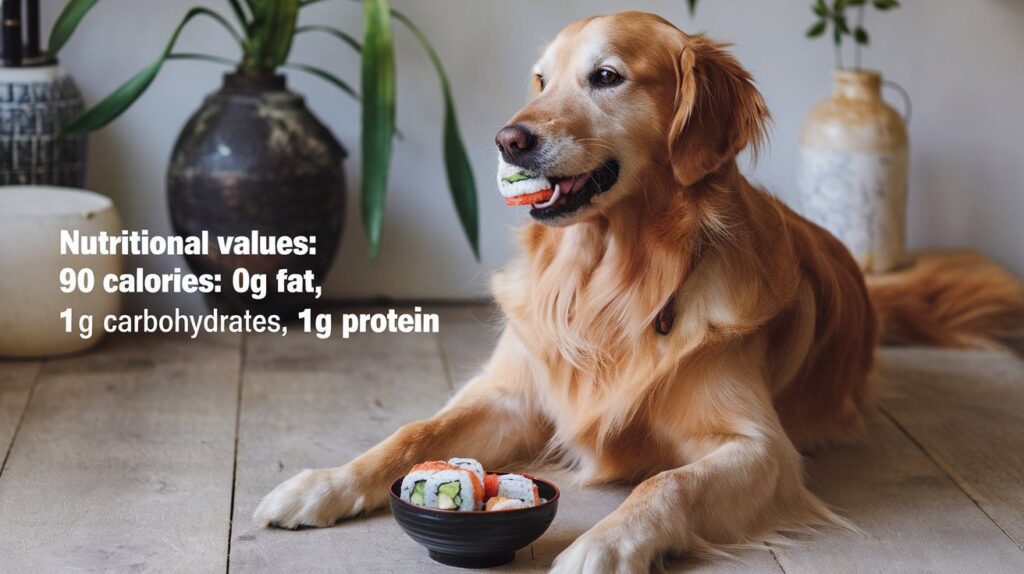
Risks of Feeding Sushi Rice to Dogs
Feeding sushi rice to dogs can sometimes be risky, and it’s essential to know why. The rice often has additives like vinegar, sugar, and salt to make it taste better for people, but these can upset a dog’s stomach or cause other serious health issues like problems with their body’s salts and minerals.
Sushi rice is also full of carbs, which might lead to weight gain in dogs if they aren’t active enough. For dogs with diabetes, this type of rice can cause their blood sugar to spike, making it harder to keep their diabetes under control.
Additionally, some dogs might be allergic to ingredients in sushi rice, such as vinegar or preservatives. This can cause symptoms like itching, hives, or tummy troubles.
If sushi rice contains raw fish, it can harbor bacteria or parasites like salmonella or tapeworms, which are dangerous for dogs and people. If you give your dog sushi rice, ensure it’s plain and has no risky ingredients or raw fish.
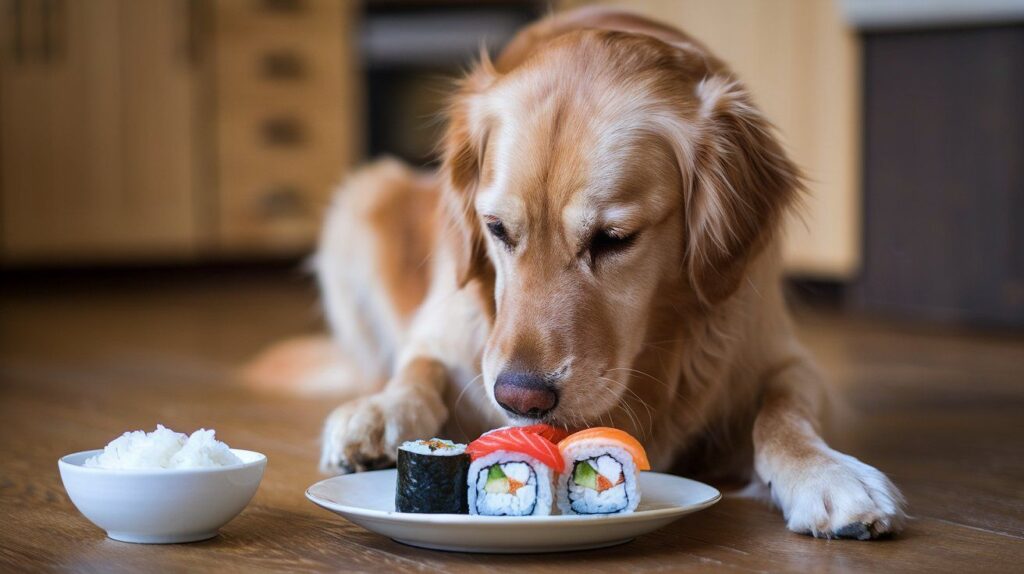
How to Safely Introduce Sushi Rice to Your Dog’s Diet
Introducing sushi rice to your dog’s diet should be done with caution and always under the guidance of a veterinarian. If you decide to offer sushi rice to your dog, here are several steps to ensure it is done safely.
- Choose Plain Sushi Rice
Start with plain sushi rice that does not contain any seasonings, such as salt, sugar, or vinegar. These additives can be harmful to dogs, so it’s crucial to use only unseasoned rice.
- Start with Small Portions:
Introduce sushi rice in small amounts. A tablespoon or two can gauge how your dog reacts to this new food. Monitor your dog closely for any signs of digestive distress or allergic reactions.
- Observe and Evaluate
After feeding your dog sushi rice, observe them for any changes in their behavior or health. Look out for symptoms like diarrhea, vomiting, or signs of discomfort, which could indicate that sushi rice does not agree with their digestive system.
- Consult Your Veterinarian
Before making sushi rice a regular part of your dog’s diet, consult your veterinarian.
- Mix with Other Foods
If your dog tolerates sushi rice well, you can mix it with their regular dog food to enhance the flavor and texture, creating a more balanced and appealing meal.
To further boost the nutritional value, consider adding other safe, dog-friendly foods like cooked beef kidney, which is rich in essential vitamins and minerals, or beef fat, which provides a concentrated energy source and supports a healthy coat.
For variety and additional nutrients, incorporating items like chicken necks and chicken feet can offer natural sources of glucosamine and chondroitin, which are beneficial for joint health. However, ensuring these are raw or adequately prepared is crucial to avoid choking hazards. Cooked chicken bones should be strictly avoided as they can splinter and cause internal injuries or blockages. Raw chicken bones, conversely, can be safer as they are softer and more manageable for dogs to chew and digest, but they still require supervision to ensure safe consumption.
- Frequency of Feeding
Treat sushi rice as an occasional treat rather than a staple of your dog’s diet. Regularly feeding dogs sushi rice can lead to nutritional imbalances and health issues due to its high carbohydrate content and lack of essential proteins and fats.
By following these guidelines, you can safely introduce sushi rice into your dog’s diet while minimizing potential risks. Always prioritize your dog’s health and dietary needs and adhere to professional veterinary advice to maintain their well-being.

FAQs
Can dogs have sushi rice sometimes?
Yes, dogs can have a bit of plain sushi rice now and then. But since it’s high in carbs, it should only be a small part of their diet. Watch how your dog reacts to new foods, and talk to your vet if something seems off.
How much sushi rice is okay for my dog?
A couple of tablespoons of sushi rice can be a treat sometimes. Mix it with their usual food so they still eat a balanced diet. Please don’t give them too much often, as it could lead to weight and health issues like diabetes.
Should some dogs never eat sushi rice?
Yes, if your dog has diabetes, is overweight, or has food allergies, it’s best to skip the sushi rice. The carbs can make these conditions worse. Always check with your vet before giving new foods to ensure they’re safe for your dog.
